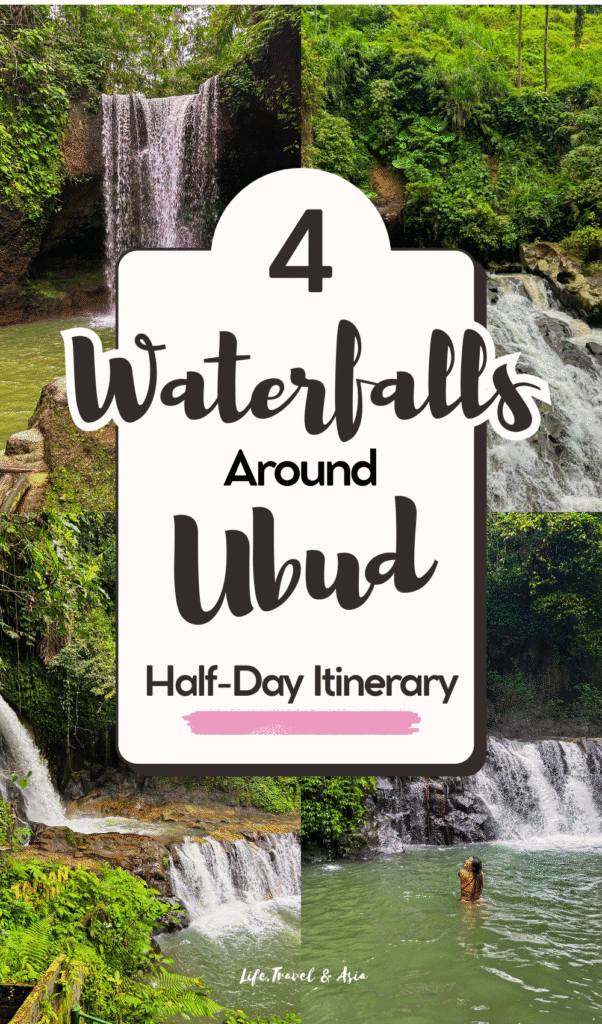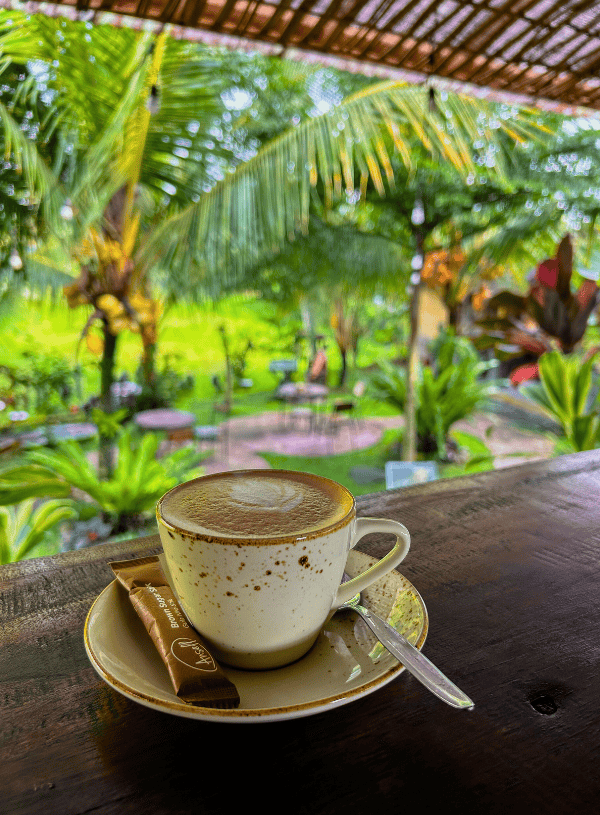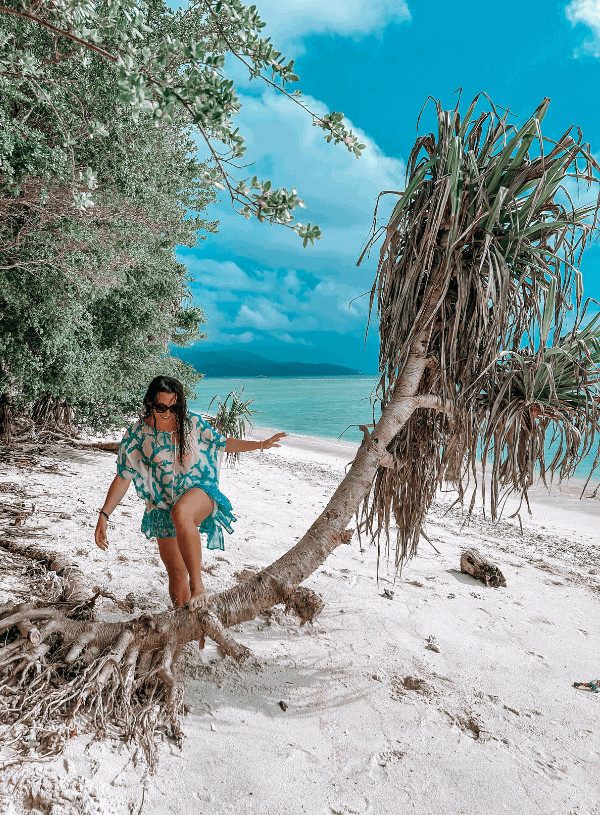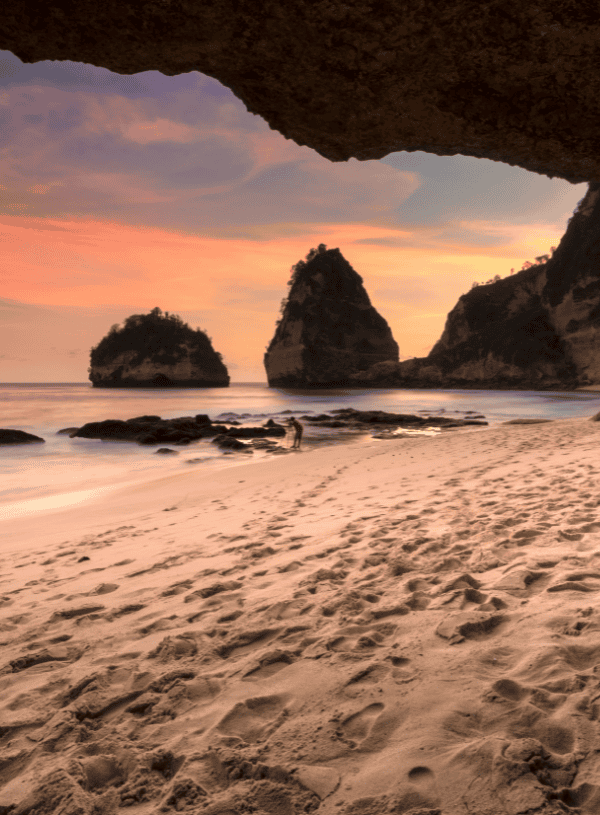Ubud Waterfall Tour: The Best 4 Falls to Visit East of Ubud
Last Updated on July 13, 2025
After my very first dip under a Bali waterfall at Leke Leke, one of the first things I knew I wanted to do after moving to Ubud was to explore as many waterfalls as possible, and honestly, it’s one of the main reasons I chose to live here.
Ubud is busy and touristy, but it only takes a few minutes to escape into peaceful village roads surrounded by jungle, fruit stalls, and sleepy dogs in the middle of the street, as if they own it.
There are so many waterfalls around Ubud that choosing where to go can be overwhelming. For this Ubud Waterfall Tour, I picked four spots east of town: Suwat, Taman Sari, Tibumana, and Goa Rang Reng Waterfalls.
In this post, I’ll share with you how I planned my not-so-self-drive half-day waterfall itinerary so you can plan your own (spoiler: I hired a Grab driver), what to bring, and a few organized tours you can check out if you’d rather not DIY it.
This article may contain affiliate links. This means that if you purchase through one of the links, I may be paid a small commission at no extra cost to you. Thank you for supporting the blog and allowing me to keep sharing meaningful travel experiences with you.
Don’t have time now?📌 Save it for later!
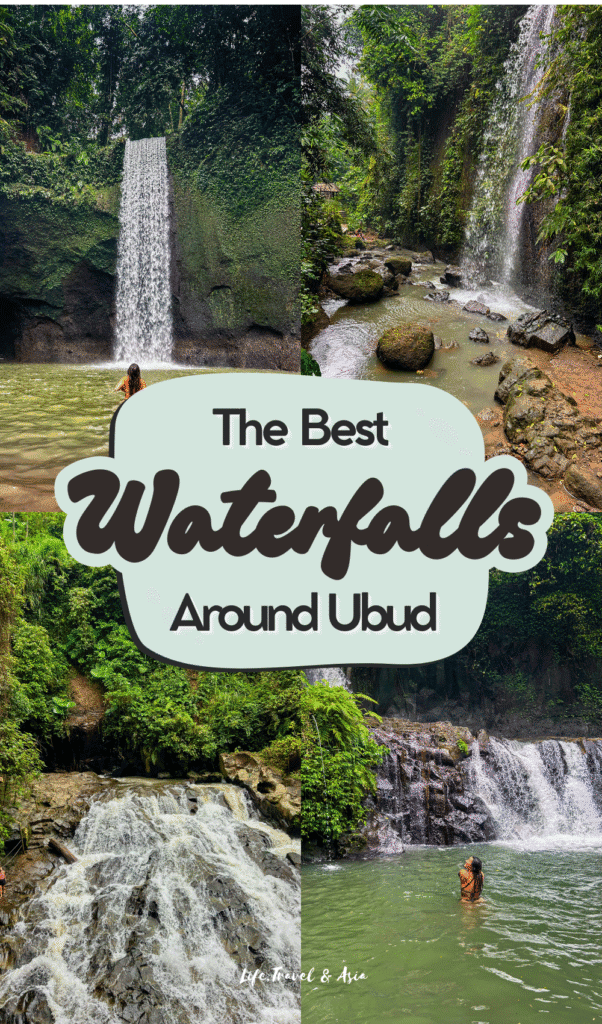
Why East of Ubud
There are waterfalls in every direction around Ubud—east, west, north, and south. You could plan four different waterfall itineraries if you’re staying here long enough.
For this first Ubud Waterfall Tour, I chose to head east for one main reason: the shorter distance from Ubud and how close the waterfalls are to each other. That’s what makes this itinerary so ideal—you can avoid the crowds, enjoy your morning in nature, and still be back in town for lunch and a relaxing spa session after all those stairs.
Whether you hire a driver or drive yourself, the roads in this area are mostly well-paved. The only slightly bumpy section is on the way to Suwat, the northernmost waterfall, where you’ll find a few potholes (and many more dogs) in the middle of the road.
I also purposely skipped Kanto Lampo and Tegenungan (at least for this time), two of the most well-known (and crowded) waterfalls near Ubud. I wanted to experience something a little quieter and more off the usual tourist path. You can always add them to it if you plan to pack more waterfalls into one day.
Waterfall Stops: Review of Each
Here’s a quick breakdown of each stop from my Ubud Waterfall Tour — what to expect, what I loved, and why each one felt unique.
What I appreciated about this itinerary is that these four waterfalls are all different. You’re not just seeing the same type of fall over and over. Honestly, if they had all looked the same (even if stunning), I probably wouldn’t even remember which one was which by the end of the day.
At one point, Putu (my driver) asked me which one I liked the most… and I couldn’t answer. One is perfect for swimming, another is more scenic, one feels sacred, and another is set in the most beautiful natural surroundings. So here’s what you can expect from each — and why I’d 100% do this exact combo again.
1. Suwat Waterfall
We started the tour with Suwat, the farthest and northernmost waterfall on the list. When we arrived, it was about 15 minutes before the official opening time, and the big parking lot was empty.
The walk down is easy and accessible (even if the walk up still involves a pretty steep staircase), with a well-paved path that will take you to the waterfall in less than 10 minutes. As you descend, you start to hear the sound of water crashing into the pool below, echoing through the jungle. You can check out the video on my TikTok to get a feel for the vibe I walked into.
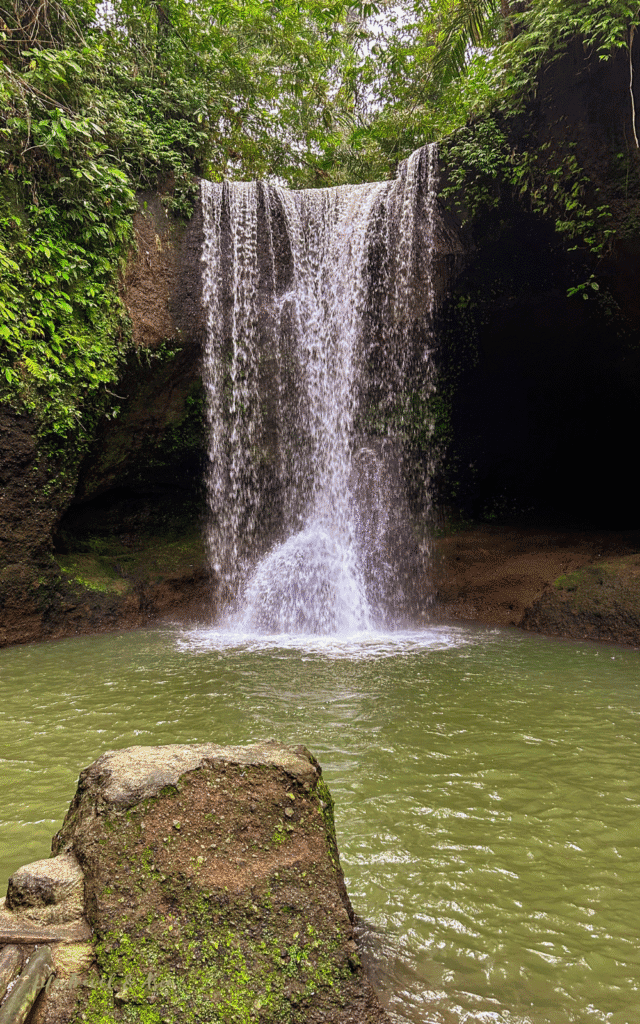
Suwat Waterfall is a single-drop cascade that flows into a natural pool where you can swim — just proceed slowly. The bottom is rocky and uneven, and the water gets deep immediately, which means you won’t always know where the stones are until you’re already stepping on them. But once you’re in, the setting is stunning.
What I loved most is how secluded it feels. Tall trees surround the entire area, forming a sort of canopy overhead. The waterfall drops from the innermost curve of a semi-circular rock wall, and when you’re floating in the water looking up, the jungle completely closes off your view of the sky.
Suwat waterfall is perfect if you’re looking for a more off-the-beaten-path spot. It’s farther out than the others, so you’re much less likely to run into other visitors, especially early in the morning.
That said, if you’re dreaming of a long, peaceful, and safe swim, this might not be the best pick. The rocky floor and deep water make it more of a “dip and float” kind of place. If swimming is your priority, the next stop, Tibumana, might be more your vibe.
2. Tibumana Waterfall
Tibumana and Suwat are pretty similar in structure — both feature a single waterfall dropping into a natural pool. So if you only have time for three waterfalls, I’d suggest picking one of the two.
That said, Tibumana is more popular, mainly because it’s closer to Ubud. I arrived around 8:30 am, and a couple was already leaving. While I was swimming, another small group of three showed up — so yes, it gets visitors even early in the morning. You can swap the order if you wish, and get to Tibumana first and then Suwat (even if it makes less sense logistically).
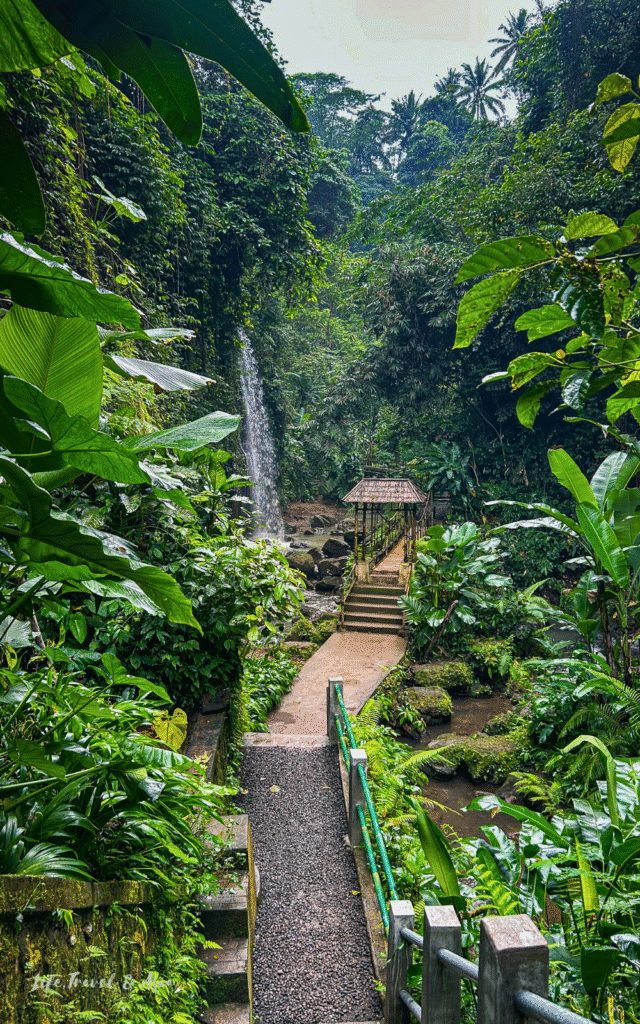
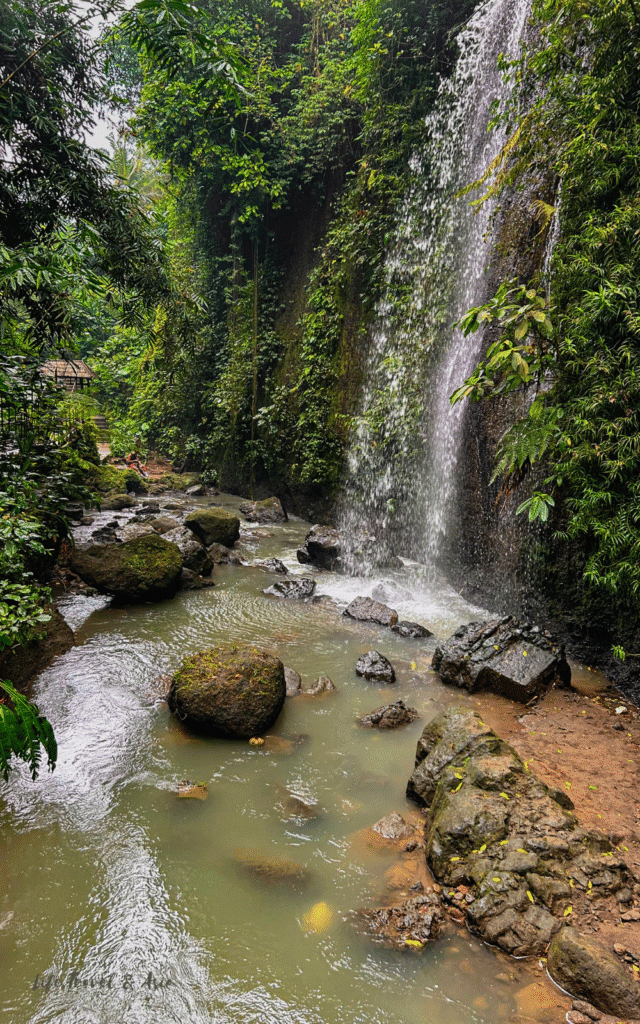
And the popularity shows. You’ll find the classic souvenir and drink stalls and small warungs along the path before reaching the waterfall. Still, the walk down is short, a well-paved (though slightly steep) staircase that takes less than 10 minutes.
As with the other falls, the jungle surrounds you, and one thing I loved here was the small second waterfall you’ll spot just before reaching the main site. You cross a cute and slightly unstable bamboo bridge to get there.
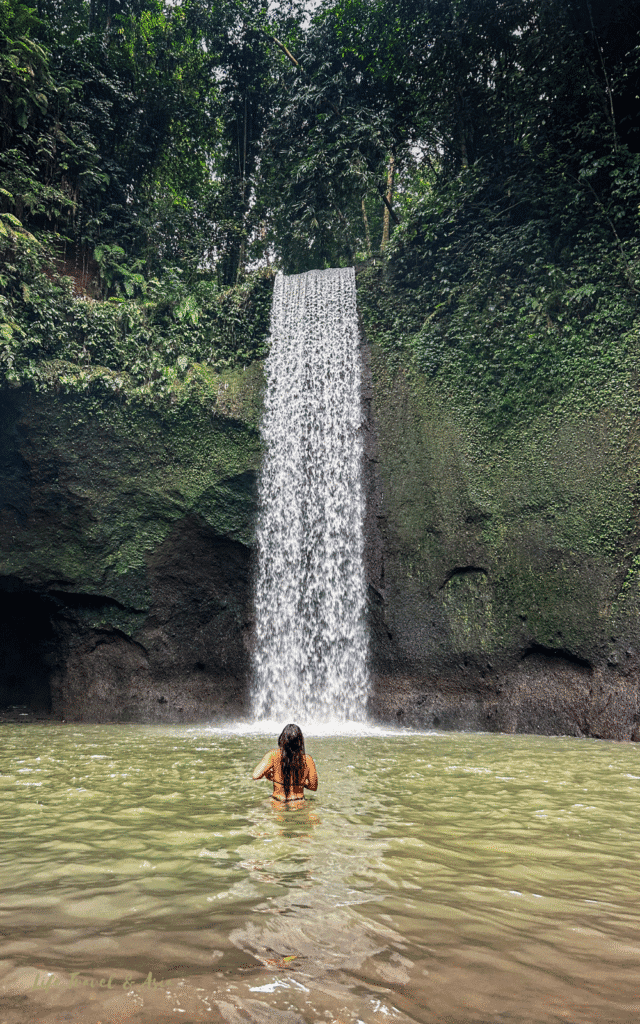

The entrance to the water here is probably the easiest of all: no rocks, no awkward drop, just a soft, sandy bottom. Perfect for swimming and taking photos without worrying about sharp stones under your feet, which is likely part of the reason it’s so popular.
Unfortunately, there was some construction work going on near the edge of the pool when I visited, which made the scene slightly less peaceful. But even with that, the experience was totally worth it.
Tibumana Waterfall is ideal if your main goal is swimming — the pool has a sandy bottom, and the water access is super easy and safe.
Compared to the other waterfalls in this itinerary, it’s also a bit more touristy, so if you want to enjoy it in peace, I recommend visiting Tibumana first and then heading to Suwat afterward.
3. Taman Sari Waterfall
Taman Sari was the most unexpected stop of the day — and honestly, if I had to choose a favorite, this might be it.
There’s something more sacred about this place. Before even reaching the waterfall, I passed a small temple, where I saw a local man praying and placing offerings. At one point, Putu even warned me not to leave my clothes in a specific spot because there was another hidden shrine nearby.
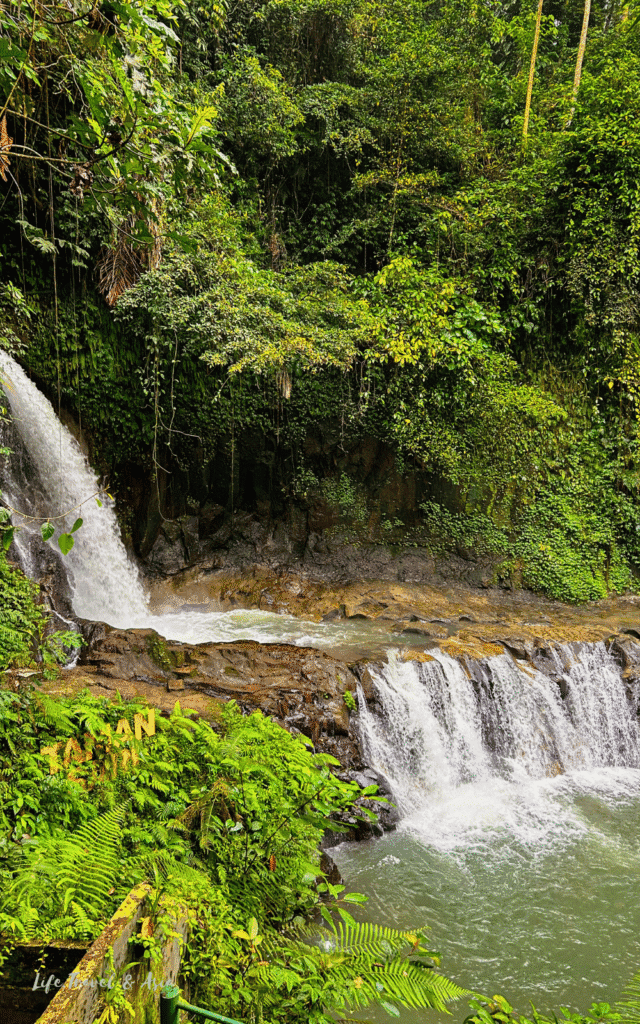
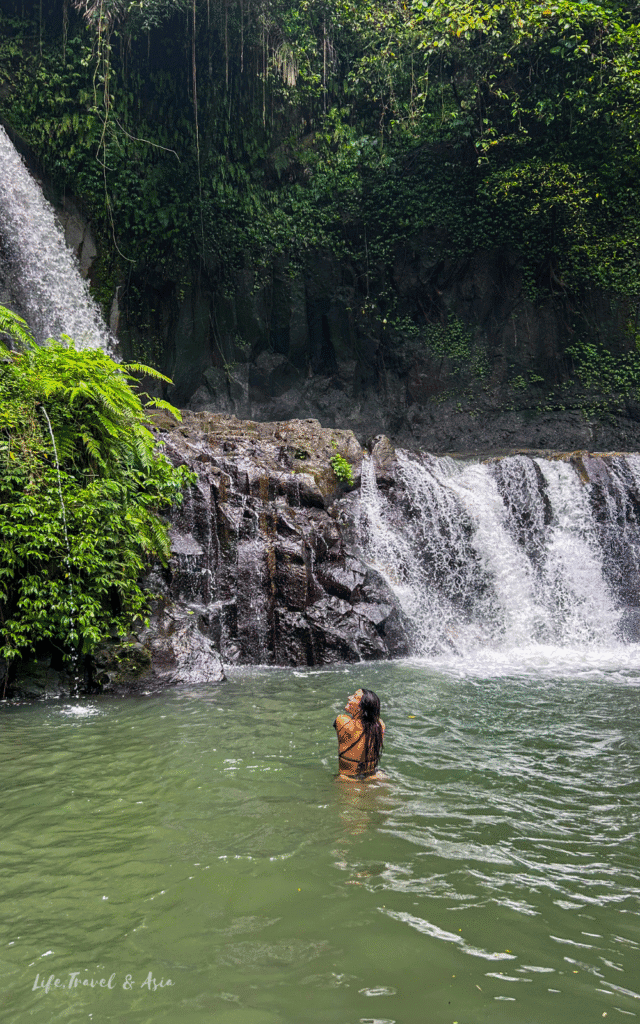
The path to the falls is a bit longer and steeper than the previous ones. Follow the paved staircase and a few helpful signs pointing the way. After a short walk, you’ll reach a changing area and the waterfall entrance.
What makes Taman Sari stand out is its structure: it’s not just one fall, but a double waterfall. A small upper cascade feeds into a larger, main waterfall that drops into a beautiful, natural pool. The water is deep but calm, and the sandy bottom makes it safe and easy to swim.
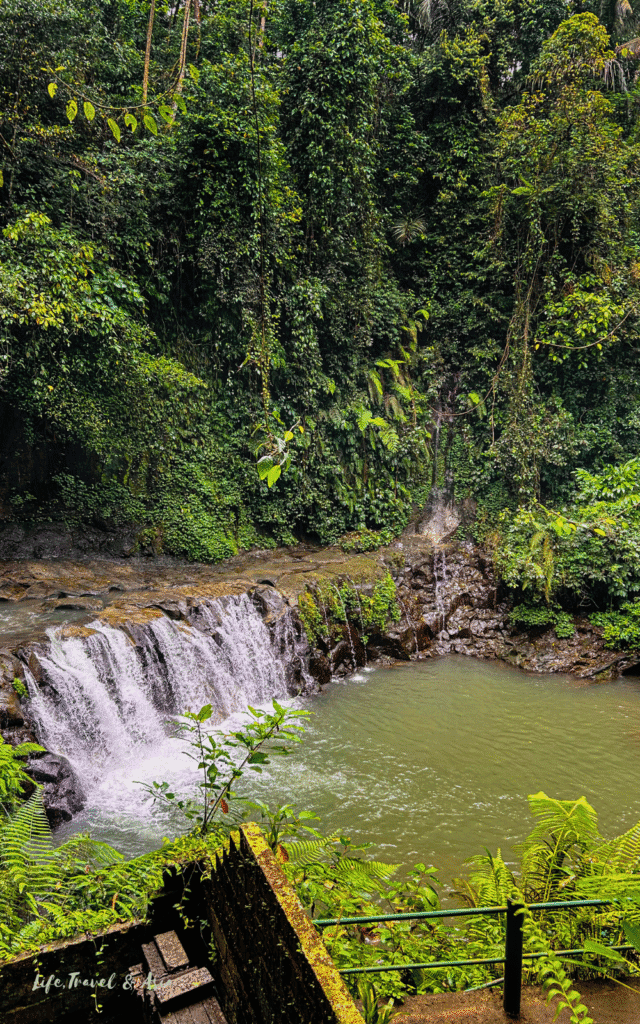
I arrived around 9 am, and there was just one other couple there. For such a gorgeous spot, that level of quiet was a gift. I 100% recommend adding this to your itinerary — even if your guide says otherwise.
One thing I’ve noticed is that many local drivers tend to suggest the more touristy or popular waterfalls. And while those are great too, don’t skip lesser-known spots like this one. Do your research, trust your gut, and stick with your plan — it’s always worth it.
Taman Sari is perfect if you’re looking to combine swimming with a structurally unique waterfall. While the water access isn’t as effortless as at Tibumana, the natural pool still has a sandy bottom, making it safe once you’re in.
Best of all is that it’s not touristy at all. Even if you visit later in the morning, you’re likely to share the space with just a couple of other visitors.
4. Goa Rang Reng Waterfall
Goa Rang Reng was the final stop on my Ubud Waterfall Tour and the only one where I didn’t swim. Let me explain why.
This waterfall has one of the most scenic and unique settings of all. It’s a wide, horizontal cascade that flows down a rock wall and continues into a rushing river below. You can climb the wet rock face by holding onto a rope located on the left side of the wall and making your way to the top of the canyon.
Make sure you’re wearing water shoes or sturdy flip-flops with a grip, as the rocks are slippery and the water current is strong.
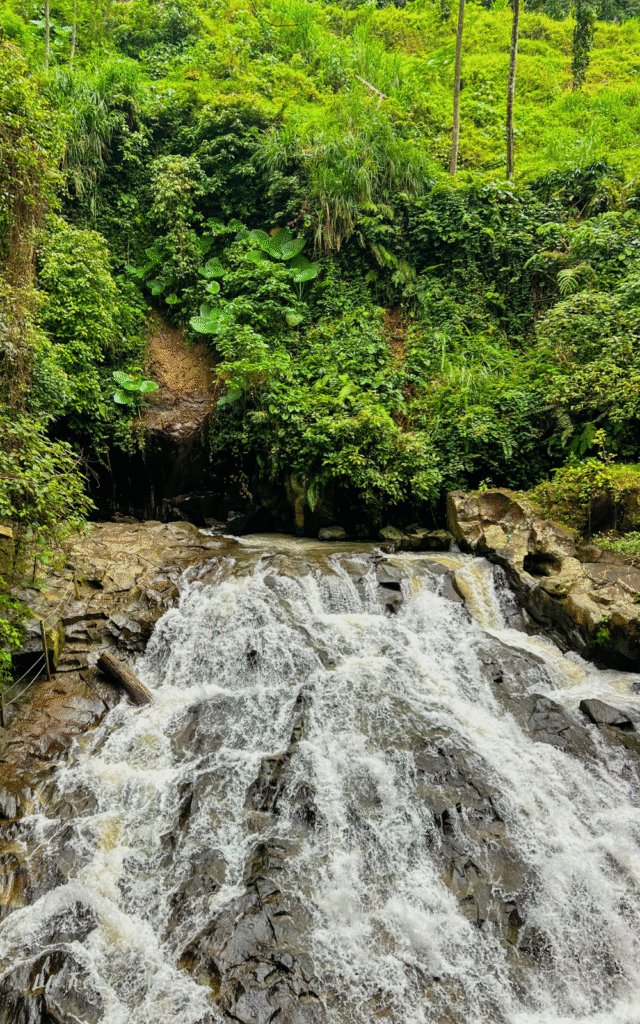
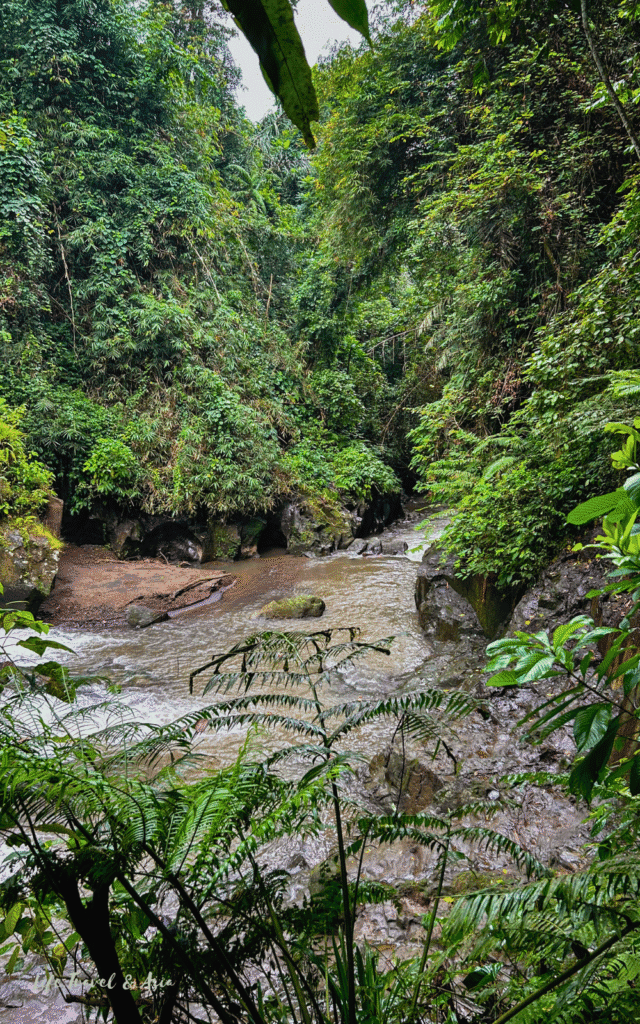
You can cross the waterfall wall to potentially take iconic pictures right in the middle of the water flowing, but here’s the issue: the current was way too strong when I visited, due to heavy rain in the previous days.
If you want to explore deeper, cross the stream, swim in the hidden canyon pool, or trek along the river, I highly recommend booking a guided tour (and the waterfall staff suggests it too). It’s not something I’d feel comfortable doing solo.
Unfortunately, most organized waterfall tours don’t include Goa Rang Reng, which is a shame. However, I did find one tour that you can consider, which includes a visit to Goa Rang Reng, and it has good reviews on the provider’s site. The provider is Summerinbali Tour, as mentioned on the tour operator. You can find them directly on Instagram for more information.
Goa Rang Reng Waterfall is incredibly scenic and truly a hidden gem — so hidden that even many local guides skip it, and it’s rare to find group tours that include it. But if you’re up for an adventure, a guided visit is the best way to experience it fully.
That said, if — like me — you’ve already had your fill of swimming after three waterfalls, you can enjoy Goa Rang Reng on your own.
Do you love adventurous itineraries and nature exploration? Then you have to be on my mailing list!
I share everything about my slow travel life around Asia — reviews, travel tips, and life-changing experiences — without hiding the not-so-glamorous side of full-time travel.
You’ll also find reflections on personal growth, because this journey is as much internal as it is external.
If you’re into meaningful adventures, I’d be happy to have you on this journey with me! No spam, just real stories, good energy, and places worth adding to your itinerary…and now let’s help you plan your waterfall tour!
Join the Journey
How To Plan Your DIY Ubud Waterfall Tour
1. How To Get To The Falls & Move Around
To explore the waterfalls east of Ubud, you’ve got two main options: rent a scooter or “hire” a driver for the day.
Renting a Scooter
This is the more affordable and flexible option, but I only recommend it if you feel confident driving on your own. Most roads are paved, but heading east means dealing with lots of ups and downs, curves, and the occasional potholes, as well as dogs running into the streets without warning.
If you’re comfortable, I recommend Ubud Scooter Rentals — they’re reliable and have a good range of scooters. Prices go from 70K to 200K IDR per day, depending on the model.
“Hiring” a Driver for the Day
If you’d rather relax on the backseat of a scooter while enjoying the rice-field scenery and snacking on granola (as I did), this is a great choice — and the one I went with.
I’m putting hire in quotes because I didn’t officially book a driver through an agency. I met a Grab driver who was super friendly, spoke decent English, and even started suggesting temples and waterfalls I hadn’t heard of.

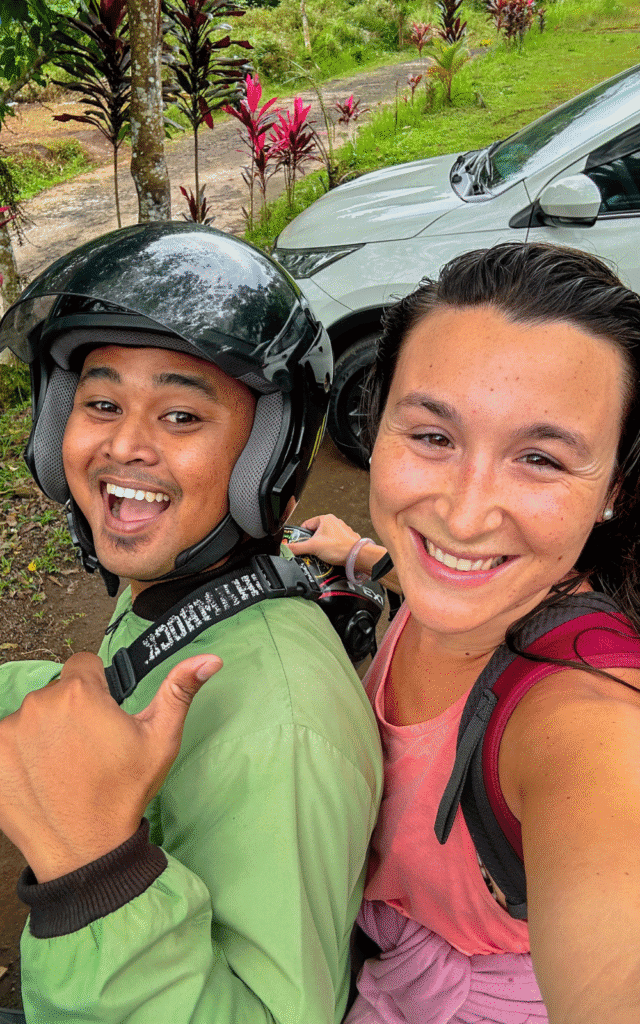
I trusted my gut, asked for his number, and ended up arranging a few day trips with him. It was the best decision.
For this particular Ubud Waterfall Tour, he picked me up at 7 am and dropped me off around 10:30. I paid 300K IDR for the morning, which I found fair. If you’re in Ubud and want to get in touch with Putu (my amazing driver!), feel free to leave a comment. I’ll happily share his contact. He’d love to show you around!
2. Departure Time
Most waterfalls in Bali officially open at 8:00 am, so I decided to leave Ubud around 7:00. I would have gone even earlier, but when I arrived at Suwat Waterfall before 8, there was no one at the ticket office yet.
I still managed to sneak in — the staircase down to the falls was only lightly blocked by a panel, which we moved without trouble. I paid the entrance fee on the way back up, and the staff were okay with it.
I imagine it’s a similar situation at most other waterfalls: if you arrive before 8, it’s usually possible to go down and pay when you come back.
That said, if you’re set on having the place entirely to yourself, you can leave around 6:30 am. Just keep in mind that the air is cool in the early morning and the water is cold, so if you’re planning to swim, going too early might make it less fun.
For me, 7:00 am was the perfect time to leave — quiet roads, no crowds, and the timing lined up perfectly with all four stops.
3. How Long Does the Ubud Waterfall Tour Take?
To help you plan your own Ubud Waterfall Tour, here’s a full breakdown of the driving times between each stop and how long I spent at each one, from leaving Ubud to coming back.
- Ubud → Suwat Waterfall: 13 km – around 55 minutes (no morning traffic if leaving at 7)
- Suwat → Tibumana Waterfall: 11 km – around 25 minutes
- Tibumana → Taman Sari Waterfall: 1.5 km – around 10 minutes
- Taman Sari → Goa Rang Reng: 2 km – around 10 minutes
I stayed about 30 minutes at each waterfall to take a dip, swim, and (of course) snap a few—or way more than a few—photos and videos. In total, the entire trip took approximately 3.5 hours, with around 1 hour and 40 minutes of driving time.
4. What To Pack for Your Waterfall Tour
As usual, I packed way too many things I didn’t end up using — because I like to be a bit of a mess when I’m surrounded by the jungle. But here are a few items you don’t want to forget:
- Cash is essential, as ticket offices don’t accept card payments. It is better to have 20K and 50K banknotes, if possible, as they sometimes don’t have change. Below is a breakdown of the entry fees I paid.
- Water shoes or sturdy flip-flops: Although there is no intense trekking or muddy paths involved, some of the stairs can become slippery, especially near the falls.
- Swimsuit
- Insect repellent: Mosquitoes are aggressive in the jungle
- Quick-dry towels: One or two, preferably microfiber, so they dry quickly and don’t stay wet in your bag all day.
- Change of clothes: Optional, but nice if you get soaked or plan to stop for lunch right after.
- Dry bag: Super useful as you’ll likely leave your bag on wet rocks or steps while swimming, and a dry bag is way better than a regular tote or backpack.
- GoPro, waterproof case, or phone
- Sunscreen & sunglasses: If it’s a sunny day, you’ll want both, especially for the scooter rides.
5. Entry Ticket Prices Breakdown
Here are the current entry fees for each waterfall (as of July 2025), so you can plan your cash. Most ticket counters only accept cash and may not have change for large bills, so it’s best to bring small denominations.
- Suwat Waterfall – 40K IDR
- Tibumana Waterfall – 25K IDR
- Taman Sari Waterfall – 25K IDR
- Goa Rang Reng Waterfall – 30K IDR
So in total, expect to spend around 120K IDR ($7.50) for entry to all four
6. Cost Breakdown: What I Spent on My Ubud Waterfall Tour
Here’s exactly what I spent on my self-organized tour, so you can plan your budget depending on how you move around:
- Driver – IDR 300K ($18.50). If you rent a scooter instead, expect to spend around IDR 150K–200K for the day
- Waterfall Entry Fees – IDR 120K ($7.50) for all four waterfalls
- Parking Fees (if renting the scooter) – Around IDR 20K total (usually IDR 5K per stop)
Total with driver: Around IDR 420K ($26)
Total with scooter: Around IDR 290K ($18)
7. The Best Organized Ubud Waterfall Tours
If you prefer enjoying the ride without worrying about logistics, here are a few tours I recommend that include some of the waterfalls mentioned in this blog post, along with a few other highlights around Ubud.
Unfortunately, it’s impossible to find a tour that includes the same combination of waterfalls I did. Still, these are good options if you’re short on time and want to pack more sights into a one-day itinerary of Ubud.
Ubud: Waterfalls, Water Temple & Rice Terraces: This full-day tour includes three waterfalls — Kanto Lampo, Tibumana, and Tukad Cepung (which I’m planning to visit soon myself, along with other northern falls). It also covers two of the most iconic sights near Ubud: the Tegallalang Rice Terraces and the Tirta Empul Water Temple. This tour is ideal if you want to combine nature and culture.
Ubud: 4 Waterfalls Tour: This is the closest tour I found to the one I did. It includes four waterfalls — Kanto Lampo (you won’t find a tour that skips it!), Bangkiang Jaran (not far from Tibumana), Tibumana, and Suwat — plus a coffee plantation visit to wrap up the day. If you’re looking for a waterfall-hopping experience without having to plan it yourself, this is a great option that still maintains diversity.
Ubud: Hidden Gems and Waterfalls: This is another top-rated waterfall tour (and a great one if you also want to check out the Tegallalang rice terraces to wrap up the day). It includes Kanto Lampo, Tukad Cepung, and Goa Raja. Goa Raja is located about an hour and a half north of Ubud, and it’s hidden inside a narrow rock canyon, with the water crashing down between stone walls. Absolutely worth it!
8. Other Waterfalls To Extend Your Itinerary
As I mentioned, there are plenty of other waterfalls east of Ubud, some more well-known, others less, that you could add to your itinerary — even though, personally, I wouldn’t recommend squeezing in more than one extra.
Sometimes quality is better than quantity, and doing more doesn’t always mean leaving happier. Waterfall hopping is fun (and also extremely tiring), but exploring slowly can be so much more rewarding than just ticking off stops.
That said, if you do feel like extending your tour, here are a few more falls located in the same area:
Kanto Lampo Waterfall: This one’s a tourist favorite. I met a woman who had just been there and told me how stunning it was — a wide, horizontal fall cascading beautifully over a rock wall. Just keep in mind, everyone is there to get the perfect Instagram shot, so if you want to go, make it your first stop of the day.
Bangkiang Djaran Waterfall: A bit more off the radar and less crowded, this waterfall is great if you want a quieter alternative. It’s located in a beautiful green valley and requires a bit more walking to reach.
You can check out the map above for even more lesser-known falls on the Eastern side of Ubud (marked in red on the map).
There you go — that was my self-organized Ubud Waterfall Tour, and honestly, I’d 100% do it all over again. If I were to change anything, it would probably be finding the courage to rent a scooter for even more flexibility… and maybe giving myself a little more time at each waterfall.
Starting the day surrounded by jungle and water is something truly unmatched — it’s one of the reasons I moved to Ubud in the first place. If you’re building your Ubud itinerary, I highly recommend setting aside at least one morning to visit some lesser-known waterfalls. It’s the best way to experience a more peaceful side of Bali.
And now I’d love to hear from you — do you know any hidden waterfalls around Ubud I should add to my list? I’m already planning a couple more days of waterfall hopping and would love your suggestions in the comments!
Did you find it helpful? 📌 Save it on Pinterest!
